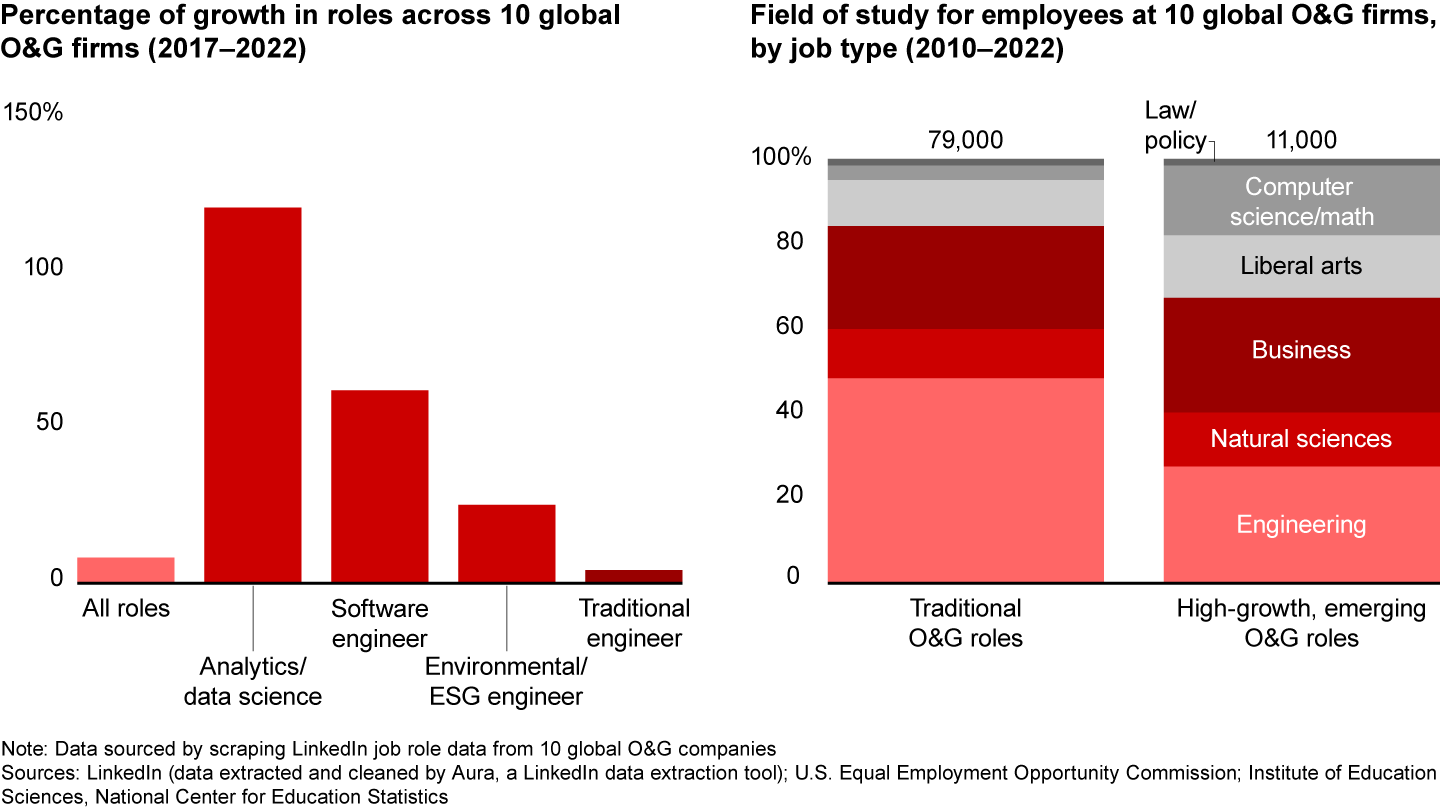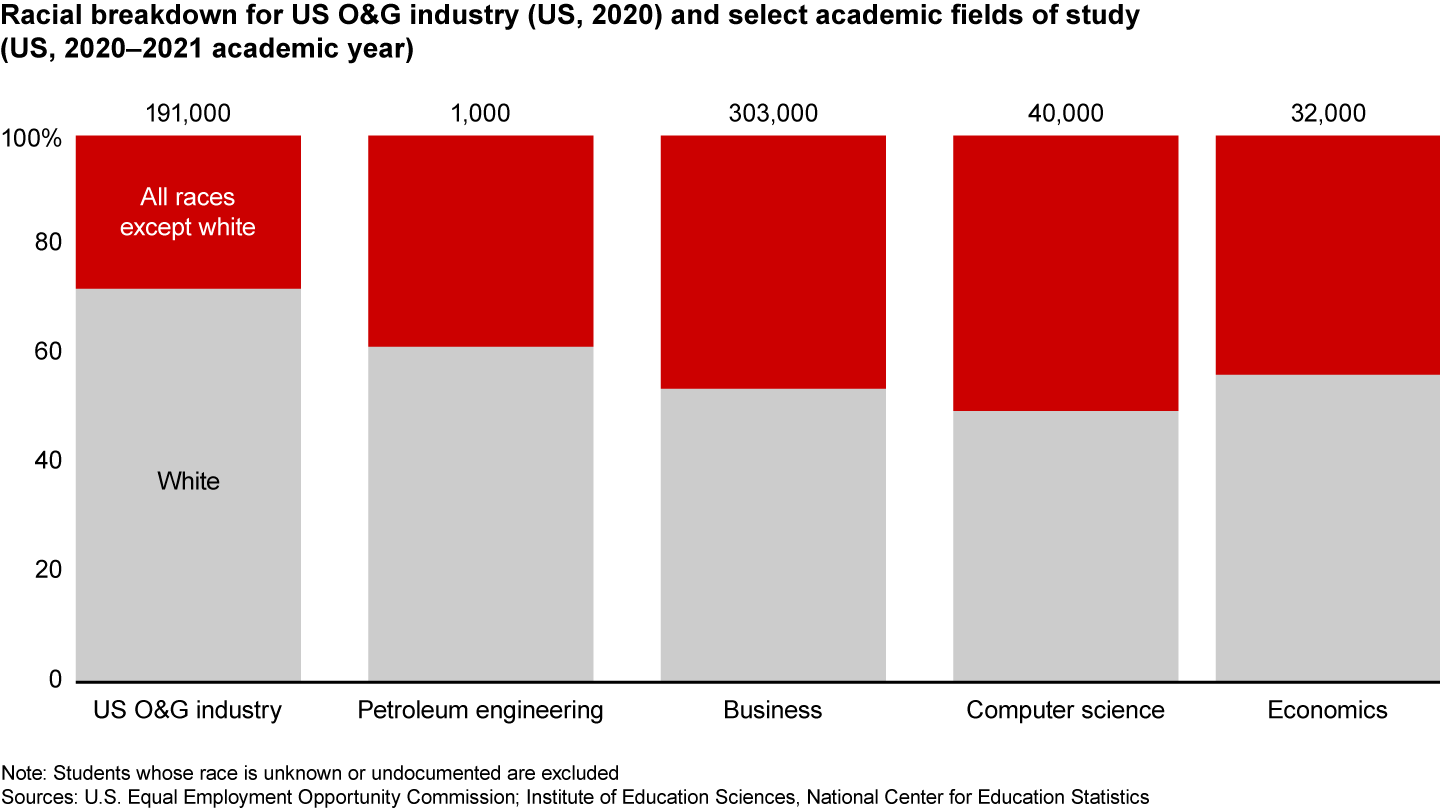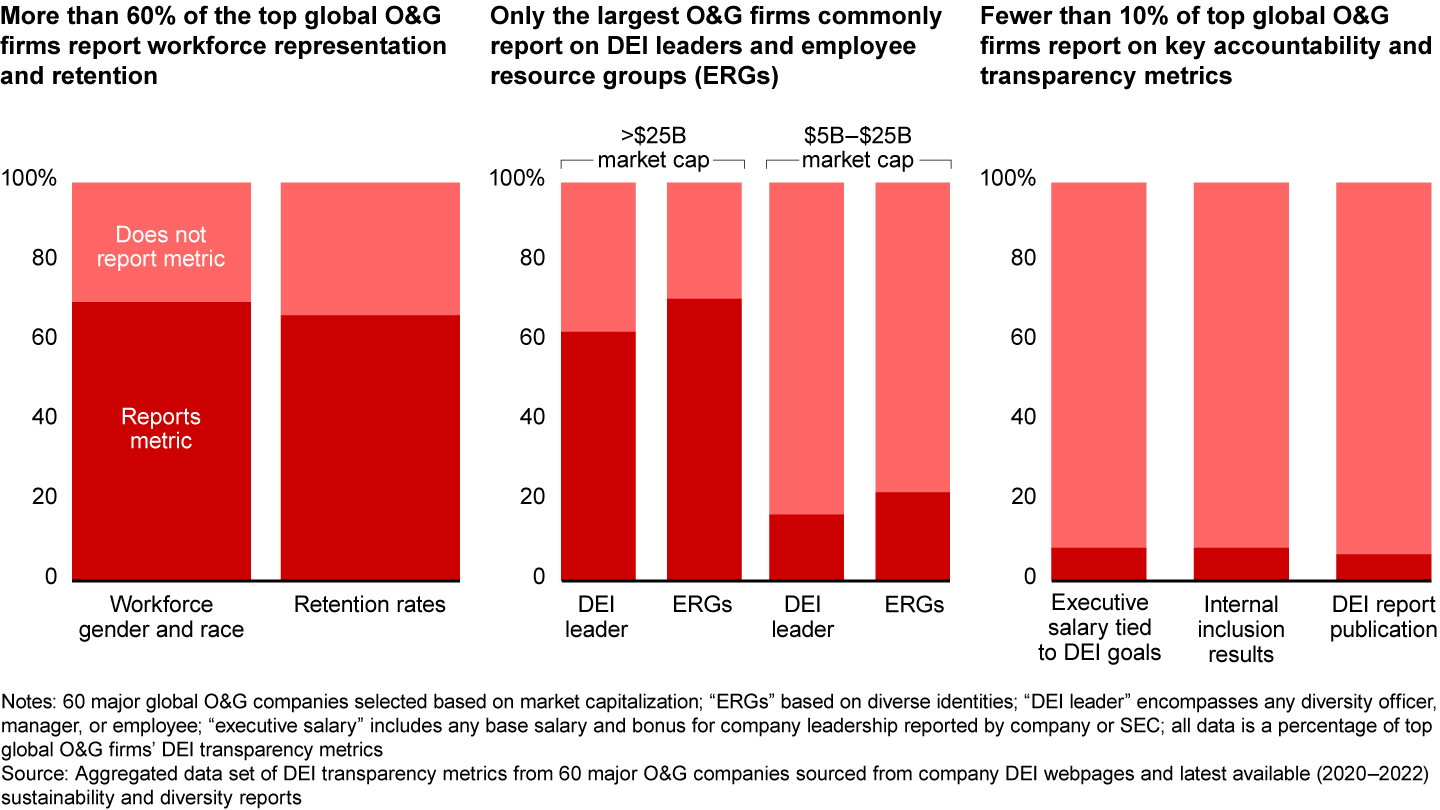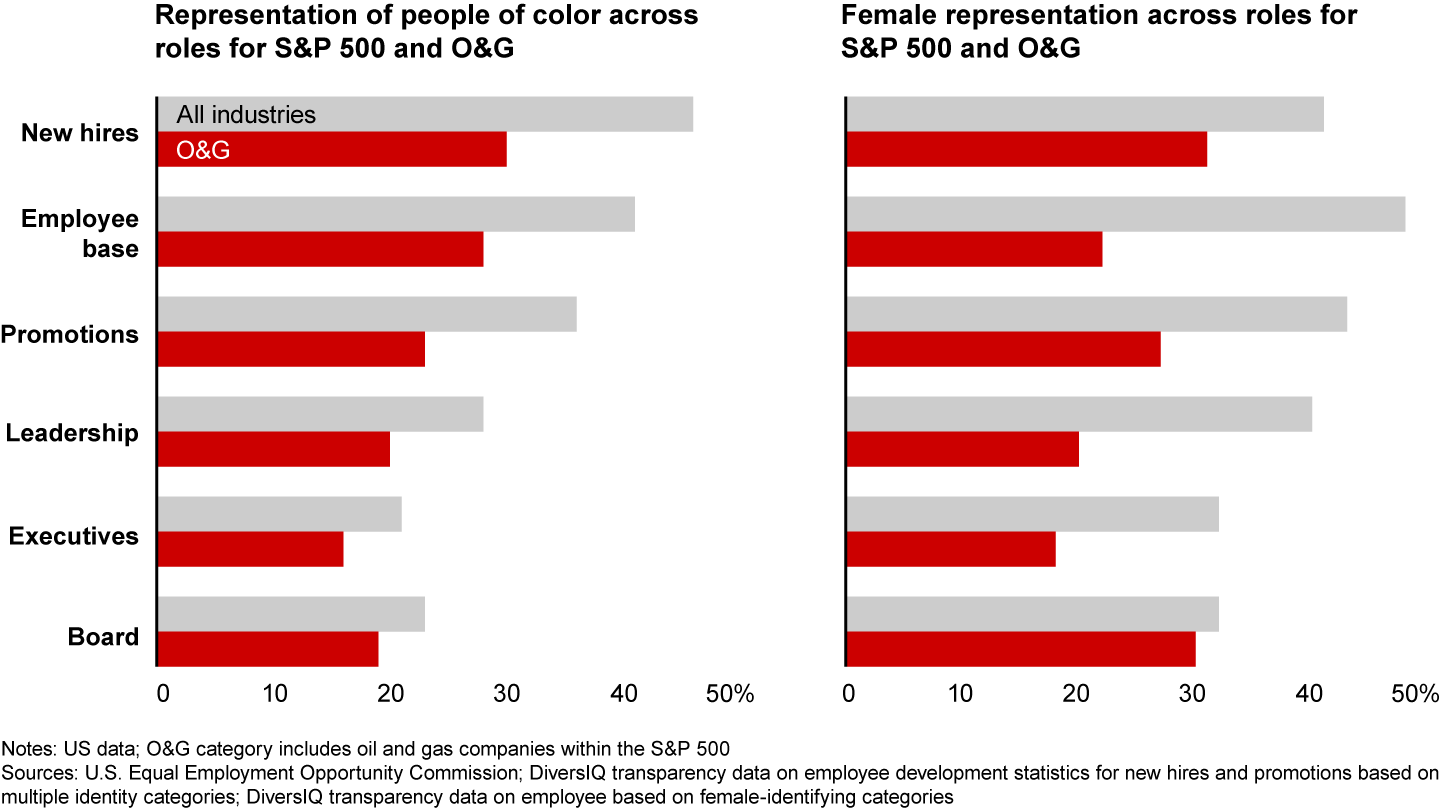Brief

Auf einen Blick
- Oil and gas companies are looking to a wider talent pool to find the people and skills they need to thrive as the industry evolves.
- In addition to traditional petroleum engineers, companies will need talent with digital, analytic, software, and economic capabilities to fill new energy roles.
- Recruiting and retaining this broader and more diverse workforce will require a step change in the industry’s approach to talent, leadership, and inclusion.
- Progress will require company-level actions such as strategy-informed workforce planning and radical transparency, as well as industrywide coalitions to change perceptions and drive progress.
All of the challenges that oil and gas companies face—the energy transition, new business models, digital technology, lower-carbon barrels—require more and different types of talent to address. For the industry at large, talent supply has become a major challenge in its own right.
The oil and gas industry has thrived for decades on the skills of a focused set of engineering backgrounds and perspectives, in a culture built around risk aversion and careful stewardship of capital. But the next chapter will be different: energy companies need new skills like data analytics, software engineering, AI and machine learning, and environmental expertise to successfully navigate the energy transition (see Figure 1). And as the great retirement continues to cycle out a generation of seasoned experts, companies will rely on a refreshed talent base of more diverse workers—in both skills and identities—to transform the energy sector and our world.

But today, many of the people with those skills are wary of working in the oil and gas industry. Many who do go to work for oil and gas don’t thrive or don’t stay, often because they may not feel included or can’t see a viable path to a leadership role. It’s difficult for anyone to do their best work in an environment where they don’t feel like they belong. This is, depending on whom you ask, a “talent″ issue, an “inclusion” issue, or a “culture” issue.
“When people have the opportunity to work at places that are more innovative and interesting, with diverse talent, it is really hard to attract people to work in an old-school work environment.”
Regardless of what you call it, to succeed, oil and gas executives will need to rethink how they hire, manage, and retain talented people. They’ll need to rewire the full ecosystem of talent strategy, sourcing, and, perhaps most importantly, retention and employee value proposition. And they’ll need to change the perceptions of the people they need the most, to make sure they can attract, retain, and reap the full benefits of these workers’ backgrounds, capabilities, and ways of thinking.

Fortunately, the oil and gas industry has a remarkable track record of solving industry-wide challenges through authentic collaboration, open dialogue, information sharing, and culture change driven through day-to-day behaviors. Companies can draw on a historical playbook of developing safety culture, including best practice sharing, unified reporting, and deeply engraining new behaviors into work environments. Powerful opportunities exist for companies to work together to change perceptions of the industry to attract and retain the talent pool of the future.
Tomorrow’s talent: Diverse skill sets, backgrounds, and identities
Historically, the oil and gas industry has tuned its culture to manage and mitigate risk. While this was critical—and remains so—the same posture of caution that is appropriate in a high-risk environment can also run counter to fostering innovation, which is becoming ever more critical. To accelerate innovation, the industry will need to widen its talent pipeline and take risks on employees with new skills and perspectives. Maximizing the potential of this workforce will be an all-hands effort, requiring new talent pipelines from a more demographically diverse pool of prospects. Bain’s research finds that academic pipelines that include high-growth roles (such as computer science, economics, and business) are more diverse than the pipelines for more traditional roles like petroleum engineering (see Figure 2). That said, it also finds that even the petroleum engineering pipeline of today is more diverse than it was a decade ago.

The path forward requires changes to the industry’s talent profile, with more diverse employees from more academic sources bringing new skill sets to the table. Finding and hiring these employees is only the first step. For them to stay, develop their careers, and contribute meaningfully to the organization, they need to feel included. Bain’s research finds that employees who feel fully included are 14 times more likely to be promoters of their organization, up to 6 times more likely to stay with the organization, and, crucially, for supporting an industry in deep transition, up to 5 times more likely to challenge the status quo. People managers play a crucial role in creating this culture, which means building skills to lead with more empathy and inclusion, while rewarding, tracking, and celebrating leadership that creates the right environments.
“[For female engineers], there’s a lot of expectations on bringing your operations personnel donuts a couple of times a week, or bringing them baked goods. I would joke with them and ask, ‘Did the male engineer before me do this?’”
Today’s landscape: The experience in and beyond the field
Today, however, female, LGBTQ+, and racial minority employees in the oil and gas industry say they feel less included and less optimistic about career advancement than their majority-identity peers. One reason for this is that rotations in the field, which are often critical for career advancement, are often particularly unwelcoming to minority-identifying individuals, who may face basic accessibility challenges, harassment, and an ongoing need to mask identities and assimilate. This design feature of the talent path, found in many companies, limits the advancement of minority populations to those who are able to endure challenging, noninclusive environments for years.
“I feel like I always have to show myself as strong, capable, empowered. You must be there all the time, proving, disproving, reaffirming your place. . . . I am not less because I am a woman.”
Going it alone: What we’re doing today
Many oil and gas leaders are aware of this disconnect between the talent needed for the future and the lived experience today. Many have begun to act with visible commitments to and investments in diversity, equity, and inclusion (DEI), particularly in the last two to three years. In 2021, 70% of large oil and gas companies we analyzed fully disclosed employment diversity data in the US, up from 4% in 2019. This compares with 55% in the overall S&P 500 in 2021. In parallel, board representation of minority-identified individuals and women is nearing parity with other industries, including technology. Most large oil and gas firms now report basic DEI stats, and leading firms invest in employee resource groups and dedicated DEI roles (see Figure 3). However, far fewer are taking more critical and difficult measures, such as tying executives’ compensation to diversity and inclusion goals or publicly reporting on internal inclusion results. There is no unified or longitudinal measure of inclusion, in the field or otherwise. About 60% of the largest global oil and gas companies don’t report gender pay equity, and 65% don’t report supplier diversity commitments.

“The company made DEI statements, but everyone saw it as a hassle. . . . Here we go again, it’s just DEI.”
DEI has not yet been fully embraced as a business capability—sometimes failing to drive meaningful results on talent outcomes and contribute to solving the broader workforce challenge facing the industry. Midsized companies in the industry are even less transparent and have yet to begin meaningfully investing in DEI basics, including reporting of representation and pay equity data.
The result is that DEI efforts, as a discipline, can feel like theatrics to employees at times, leaving a long way to go in expanding and diversifying the industry’s talent—with no time to lose. While no industry has cracked the code on equity and inclusion, the imperative for oil and gas to recruit more diverse talent and unlock their full potential could not be more pressing.
“I have never felt such a strong need to be masking [as I did in the field]. Very masculine in the heteronormative way. It was so pervasive.”
In spite of this, the industry made no meaningful progress in gender and racial representation in the five years leading up to 2020 (see Figure 4). In the US, representation of women in oil and gas is about 35% to 45% lower than in the general working population, 30% to 40% lower for Black people, and 35% to 45% lower for Asian people. These numbers suggest that the industry is not yet attracting a wider range of people who will bring in new skill sets and ways of thinking—which is the true business value at stake, to say nothing of doing the right thing by employees.

Broad cultural change is needed across the sector
The energy transition provides the oil and gas sector with an unprecedented opportunity to make permanent, transformative changes in its talent ecosystem and to leapfrog other industries on building diverse, inclusive organizations. Innovation and performance are imperatives for oil and gas companies that want to thrive during the transition. Research suggests that diverse teams make better business decisions 87% of the time, and diverse leadership teams are 1.7 times more likely to capture a new market—a critical skill for tomorrow’s energy leaders.
“Energy sustainability and diversity, equity, and inclusion go hand-in-hand. We are going to see a positive shift, because it’s a necessity. In our business, sustainability takes on a lot of faces.”
Building more diverse, inclusive, and equitable organizations is an indissoluble piece of the oil and gas industry’s talent challenge and a leading indicator on an organization’s readiness to adapt to new conditions. Individual companies will need to make meaningful investments in shaping their cultures toward greater inclusion, redesigning employee value propositions, and creating equitable career paths. The journey will vary from firm to firm, but critical investments will include:
- Take a future-back view on talent. Apply sharp, rigorous workforce planning deeply informed by strategy, market demand, and current attrition trends to inform where and how to focus efforts.
- Align and enroll leadership around the case for change, DEI ambitions, and measurable goals—using a mix of head and heart.
- Invest in upskilling your people capabilities. Changing the workforce and solving talent gaps will require sharper skills from human resources, cultural leaders, and managers to identify gaps, change behaviors, align systems to create greater inclusion, and build and model empathic leadership.
- Build the infrastructure for progress, including data tracking and measurement, dedicated DEI teams and committees, and executive incentives.
- Ensure transparency, with annual reporting and longitudinal views, and use this transparency internally and externally to drive progress.
At the same time, the industry will need to work together to change public perceptions about working in energy, make progress on inclusion, and attract a stronger and more diverse workforce. Committing to broad efforts like the International Association of Oil & Gas Producers’ Workforce Energy initiative can help address the challenge by encouraging companies to:
- Commit to cross-industry collaboration on DEI efforts
- Standardize DEI metrics with minimum commitments and transparency expectations
- Share best practices, recognizing this is an industry-wide challenge with shared opportunity
- Build a monitoring infrastructure to ensure public accountability
“We still have a long way to go. We have lost some people at the lower levels because they do not see people that look like them above them in the company.”
Industry partnerships will make it possible (and less risky) to standardize metrics and improve transparency. These collaborations will be essential for standardizing DEI metrics, facilitating transparency, and encouraging best practices to spur change. But the journey ahead is long and will require a serious commitment to questioning old ways of working.
The talent challenge is huge, but by working together and tapping their deep experience in managing transformation, oil and gas companies can make the changes necessary to find, attract, and realize the benefits from a broader and more diverse talent pool.



